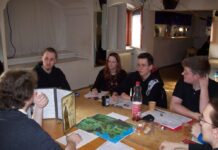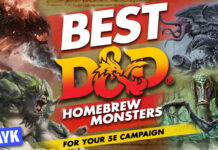D&D campaigns are naturally long. A typical D&D campaign can last for more than five sessions, and it can even get longer if the players are taking many sub-quests and tasks. While long D&D campaigns are fun, they can drag too much and compromise everyone’s schedules.
Well, the solution is to make a short campaign. However, this task is easier said than done because most DMs and players are used to having long, dragging campaigns and adventures.
If you want to start a short yet effective D&D campaign, this article can truly help. We’ll cover the basics of running short campaigns, as well as some helpful tools for DMs.
Why Do You Need A Short D&D Campaign?
Basically, you need a short D&D campaign to save time. Instead of planning a campaign with 10+ sessions, you can wrap everything under five sessions and focus on dynamic storytelling.
Also, a short campaign will free your schedule to run several one-shots per month. This will avoid burnout and help you enjoy being a D&D player (aside from being a forever DM) every now and then.
Lastly, you can reduce costs with a short campaign. It’s very likely that you’ll need fewer miniatures, accessories, and snacks for a campaign that has less than ten sessions. If your campaign is online, well, you can save electricity costs and gain more time to pursue career opportunities.
How to Create A Short D&D Campaign?
Creating a short D&D campaign isn’t too difficult. In this article section, we will introduce you to some essential campaign-making techniques and strategies.
Let the Narrative Take Over
The narrative is the heart of any tabletop campaign. Without the narrative, the campaign will have nothing but boring set-piece monsters, table props, and less dedicated players. Therefore, it’s important for all DMs to improve their campaign narratives consistently.
Now, a truly dynamic narrative can be the cornerstone of a short D&D campaign. Instead of running a static narrative where players can go from Point A to Point B, you can introduce explosive social encounters meant to push the plot forward. Even if your campaign has multiple plot points, you can always reveal two major directions: victory or defeat.
High-octane plot encounters will keep your players interested and move your campaign forward. Try to keep the stakes high and don’t put too much side-quests on every location.
Don’t Be Afraid to Speed Up Combat
Combat is one of the few things that often slow down a campaign. A ten-round encounter can last for more than three hours, especially if all of the players involved are beginners. This is actually normal in the tabletop scene, but there are numerous workarounds.
One way to speed up combat is to combine similar monsters or foes in one initiative stack roll. By combining multiple initiative stacks, you can save up to 10 minutes or even more!
It’s also wise to have those monsters act as one entity during their turn because they are easier to track. Plus, you can make the combat more challenging by targeting players with several ferocious monsters.
Another technique that you can try is fast-resolution combat. First, you must describe the battlefield and the initial positions of monsters accurately. Second, ask your players about the different actions they want to take. You probably need to make multiple dice rolls to move the encounter forward. In the end, the combat will look seem like a discussion panel among strategists and roleplayers. The fast-resolution combat can save 3-5 hours of precious time.
Set Goals and Expectations Properly
Before implementing uncommon ways to shorten a campaign, you must set specific goals and expectations. One goal that you can set is a time limit for every session. Regardless of what happens, the session will end once the time limit is over. Enforcing this goal is not a bossy act but rather a way of maintaining discipline.
When it comes to expectations, just be honest with your players. Tell them that you intend to run a short yet interesting campaign instead of a long and boring one.
Use Random Generators Often
Creating a campaign from scratch is a wonderful yet tiring journey. As a DM, you need to prepare everything and ensure that schedules are being followed. If you’re not careful, you might suffer from creative burnout.
One easy way to avoid creative burnout is to use random generators. There are tons of random generators that you can find online. These generators will show results based on dice rolls. Within seconds, a generator can bring out loot types, prompts, encounters, and even dungeon maps.
Generators won’t hinder your creative progress. On the contrary, they will help you save time and focus on the other aspects of your campaign!
FAQ About Short D&D Campaigns
What is the best genre for a short D&D campaign?
Answer: There is no definite answer but you should look along the lines of horror, golden age of piracy, and low fantasy. These genres can be straightforward with continuous action scenes between sessions.
What should be the maximum level for a short campaign?
Answer: The advisable maximum level is within 10-12. Anything that goes beyond that range will drag the campaign and make it long.
How long should a regular campaign session be?
Answer: Try to keep a campaign session under five hours or less. If a session goes beyond five hours, it can mess up players’ schedules and priorities.
Final Reminder
Running a short campaign still requires hard work and dedication. However, a short campaign is five times easier to run than a long campaign. Just imagine the hours that you and your players can save!
Do you have other ideas about short campaigns? Share your thoughts in the comments’ section below!






